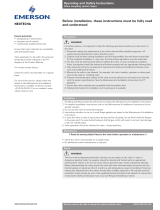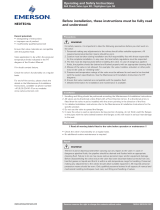Page is loading ...

KTM HINDLE ULTRA-SEAL SERIES 300 TWO PIECE CRYOGENIC
INSTALLATION AND MAINTENANCE INSTRUCTIONS
Before installation these instructions must be fully read and understood
VCIOM-03759-EN 15/06
1 STORAGE / PROTECTION / SELECTION
Storage
When valves are to be stored for some time
before being fitted, storage should be in the
original delivery crates with any waterproof
lining and/or desiccant remaining in place.
Storage should be off the ground in a clean, dry,
indoor area. If storage is for a period exceeding
six months the desiccant bags (if supplied)
should be changed at this interval.
Protection
KTM Hindle valves are delivered with protection
according to customer's specification, or in
accordance with the Quality Assurance Manual,
to protect the valve seats and closure member
from damage. Wrapping and/or covers should
be left in place until immediately before fitting
to the pipe.
Selection
Ensure the valve’s materials of construction
and pressure/temperature limits shown
on the identification plate are suitable for
the process fluid and conditions. If in doubt
contactKTMHindle.
3 OPERATION AND ROUTINE MAINTENANCE
!! Read all warning labels fitted to the valve
beforeoperation or maintenance !!
Scope
KTM Hindle Series 300 Cryogenic Valves both
manual and actuated.
Operation
All standard manually operated valves are
‘clockwise to close’. The closed position is
indicated by either the handlever or indicator
arrow being at 90° to the pipe/valve bore axis.
Routine maintenance
No routine maintenance is required other
than periodic inspection to ensure satisfactory
operation and sealing.
Any sign of leakage from the gland packing
should be addressed immediately by
depressurizing the valve and tightening the
gland nut. If no further adjustment is possible,
or if seat or joint leakage is suspected, the valve
will require a complete overhaul.
2 INSTALLATION
WARNING!
For Safety reasons, it is important to take the
following precautions before you start work
onthevalve:
1. Personnel making any adjustments to the
valves should utilize equipment and clothing
normally used to work with the process
wherethe valve is installed.
2. The line must be depressurized, drained
andvented before installing the valve.
3. Handling and installation of all valves,
operators and actuators must be carried
out by personnel trained in all aspects
of installation and manual/mechanical
handlingtechniques.
4. Ensure the valve pressure/temperature
limitations marked on the identification label
are above or equal to service conditions.
This should be carried out after
depressurisation and in accordance with
KTMHindle Maintenance Instructions. Only
KTM Hindle spares should be used.
Spare parts
KTM Hindle valves are identified by a figure
number, stamped on the identification plate,
located on the valve body flange. This reference
should be quoted in respect of any after sales
queries, spare parts or repair enquiries/orders.
1. KTM Hindle Series 300 low temperature
valves for -50°C service and above are
bi-directional as standard and may be
fitted in either direction. Valves for service
below -50°C are uni-directional and
should be fitted with the body seat located
downstream.
2. Installation of cryogenic valves should
be carried out with the extension bonnet
displaced within 45° of vertical.
3. Remove protective covers from valve faces.
4. Ensure that mating flanges and gaskets are
clean and undamaged.
5. Possibility of abrasive particles (weld slag,
sand etc.) within the piping system could
damage valve seating/ball. The system will
need to be flushed clean.
6. Ensure mating pipe flanges are aligned
correctly. Bolting should be easily inserted
through mating flange holes.
7. Fit the valve into pipework ensuring easy
access of the lever/handwheel.
8. Tighten the flange bolts in a diagonal pattern.
www.valves.emerson.com © 2017 Emerson. All rights reserved.

2
KTM HINDLE ULTRA-SEAL SERIES 300 TWO PIECE CRYOGENIC
INSTALLATION AND MAINTENANCE INSTRUCTIONS
4 MAINTENANCE
CAUTION
Before attempting any maintenance, ensure
the system has been fully depressurized and if
necessary drained of any dangerous fluids. The
valve being removed should be operated at least
once and left in half open position before removal.
Before disassembling the valve, ensure the valve
has been decontaminated correctly from any
harmful gasses or fluids and that it is within a
safetemperature range for handling.
Personnel making any adjustments to the valves
should utilize equipment and clothing normally
used to work with the process where the valve
isinstalled.
Handling of all valves, operators and actuators
must be carried out by personnel trained in all
aspects of manual and mechanical handling
techniques.
Parts identification
The illustrations in Section 5 show the parts
comprising the Series 300 Series valves.
Item numbers for spare parts should be
identified from GA Drawings supplied, or
exploded views shown in the illustrations.
4A: Replacement of valve components
If no further adjustment of the gland is
possibleand shaft leakage is still evident or
seat leakage is suspected, the valve will need
to be removed from the line in order for new
seats/seals to be fitted.
After removal of the valve, place the valve on a
workbench and adopt the following procedure
to remove/replace the seats/seals.
1. Remove connector bolting, and connector.
2. Remove connector seat ring and ball.
3. Remove body seat ring, shaft and thrust
bearing.
4. Remove the operator (lever, gearbox,
actuator) in accordance with instructions
inSection 4B.
5. Remove bonnet screws and bonnet.
6. Remove gland nut, tab washer, Belleville
washers and gland ring.
7. Remove extension shaft, primary shaft
sealand bonnet fire-seals
8. Remove shaft spacer and bonnet
primaryseal.
Refitting is the reversal of removal.
Before refitting, ensure all sealing and metallic
surfaces in seat pockets and shaft seal bores
are free from damage/corrosion. Minor defects
can be polished using abrasive cloth. If major
defects are found, contact KTM Hindle for
possible repair or component exchange.
4B: Removal and refitting of operator
Removal of handlever/T-bar
1. Remove the shaft nut and tab washer/T-bar
screw and washer.
2. Remove the handlever/T-bar.
Removal of gearbox/actuator
1. Remove bracket screws.
2. Remove mounting bracket and gearbox/
actuator.
3. Remove drive adaptor.
Refitting is the reversal of removal.
4C: Setting of travel stops on gearbox and
actuated operators
See Figure 4 Section 5 for diagram of travel
stoppositions
(a) With valve out of pipeline:
1. Close valve fully.
2. Remove plastic indicator cover from top
ofgearbox.
3. Release closed stop screw.
4. Align diamond shaped drive points
parallel to valve bore as shown in Figure 4
(Section5).
5. Tighten closed stop screw, allowing for
backlash between adaptor and shaft.
6. Hold stop screw in position with Allen
keyand tighten locking nut.
7. Open valve fully.
8. Visibly check that ball port is aligned
with valve bore. If incorrect follow rest of
procedure.
9. Release open stop screw.
10. Adjust ball position using handwheel
untilvalve is porting correctly.
11. Tighten open stop screw and lock off
withlocknut.
(b) With valve in pipeline:
Adopt steps 1-6 as above for open and closed
positions.
Note: for the setting of stops on actuators,
seeseparate instructions.
Orientation of gearbox
1. As standard, gearbox input shaft is across
line with the offset opposite the valve body
connector end.
2. Orientation of input shaft can be rotated
through 180º if required. This requires
removal of gearbox screws, rotation of
gearbox through 180º, and refitting of
gearbox screws.

3
KTM HINDLE ULTRA-SEAL SERIES 300 TWO PIECE CRYOGENIC
INSTALLATION AND MAINTENANCE INSTRUCTIONS
4D: Actuator assembly
Prior to assembly, check the following details:
1. Actuator type and style, i.e. double acting or
spring return.
2. Position of actuator in relation to valve and
pipeline.
3. Fail-safe position of valve, i.e. open or
closed.
Assembly
1. Close valve fully.
2. Remove handlever/T-bar/gearbox as per
Section 4B.
3. Remove stop screws and stop collars.
4. Ensure that adaptor coupling is a good fit
with actuator drive and extension shaft.
5. Position mounting bracket on to valve and
fitbracket screws. Do not tighten.
6. Position adaptor coupling on to valve.
7. Assemble actuator over adaptor coupling
and on to mounting bracket.
8. Fit actuator screws. Do not tighten.
9. With actuator secure, check for free
alignment of adaptor coupling between
actuator drive and extension shaft. Tighten
mounting bracket screws and re-check
alignment.
10. With actuator in correct position, tighten
actuator screws.
11. If the actuator is fitted with travel stops,
adjust to the closed position. Operate to the
open position and adjust so that the ball port
is aligned with the valve bore.
FIGURE 1
Bonnet top and actuator diagram
(Model shown is NPS 3)

4
KTM HINDLE ULTRA-SEAL SERIES 300 TWO PIECE CRYOGENIC
INSTALLATION AND MAINTENANCE INSTRUCTIONS
FIGURE 2
Typical component assembly drawing
(Model shown is NPS 1½)
PARTS LIST
Item Part name
1 Body
2 Connector
4 Bonnet
7 Ball
8 Shaft
9 Extension shaft
21 Gland collar
22 Antistatic ball (shaft/ext. shaft)
23 Antistatic spring (shaft/ext. shaft)
24 Body seat
25 Connector seat
29 Gland spring
30 Shaft nut
31 Tab washer
33 Shaft thrust bearing
41 Shaft spacer
50 Body stud
51 Body nut
52 Bonnet screw
60 Body primary seal
62 Bonnet primary seal
65 Shaft primary seal
70 Body fireseal
72 Bonnet fireseal
90 Handlever
93 Stop screw
94 Stop collar
5 COMPONENT AND ASSEMBLY DRAWINGS

5
KTM HINDLE ULTRA-SEAL SERIES 300 TWO PIECE CRYOGENIC
INSTALLATION AND MAINTENANCE INSTRUCTIONS
FIGURE 3
Typical component assembly drawing T-bar assembly
(Model shown is NPS 3)
PARTS LIST
Item Part name
21 Gland collar
29 Gland spring
30 Shaft nut
31 Tab washer
72 Bonnet fireseal
93 Stop screw
94 Stop collar
104 T-bar adapter
105 T-bar tube
106 T-bar washer
107 T-bar screw

6
KTM HINDLE ULTRA-SEAL SERIES 300 TWO PIECE CRYOGENIC
INSTALLATION AND MAINTENANCE INSTRUCTIONS
FIGURE 4
Typical component assembly drawing gearbox assembly
(Model shown is NPS 3)
PARTS LIST
Item Part name
96 Gearbox
97 Mounting bracket
98 Gearbox screw
99 Bracket screw
100 Coupling
102 Handwheel
108 Handwheel pin
Closed position
travel stop
Open position
travel stop
© 2017 Emerson. All rights reserved.
/

